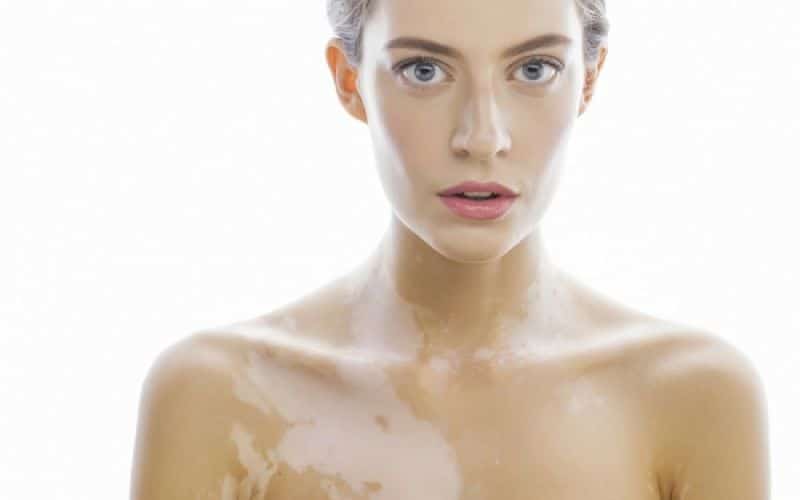Vitiligo is considered an autoimmune disease which means that for an unknown reason the body (the immune system) destroys some of its melanocytes, as a result of which melanin is not produced in those parts of the skin, so the skin completely loses its color and becomes discolored (whitens). Vitiligo is estimated to occur in 1 % – 4% of the general population worldwide. In Greece this percentage ranges from 2.5%-3%. It can be congenital, i.e. appear from birth (about 1/3 of the cases) or later in which case it is called acquired (about 2/3 of the cases).
It is more common in sunny countries especially in northern Africa, and has been described as a "disease of the light", as the sun enhances the contrast between the "tanned" healthy skin and the discolored diseased skin.
It is introduced most often before the age of twenty. It appears as one or more spots without any pigment (color), which usually first appear around normal openings (around eyes, genitals) or in areas of skin friction such as elbows and knees.
The evolution she is unpredictable. Some spots stabilize, while others expand and coalesce with neighboring ones to form larger plaques. In some cases, there is also an automatic regression of the disease. In other words, there is no way to predict the progression of vitiligo. It may remain as it is, expand, or heal itself.
Sometimes the achromatic spots occupy the whole body and may even affect the bristles and hair (white tufts). Caution! What is certain is that vitiligo is not transmitted, it is not a contagious disease and it does not create a health problem. This is a purely aesthetic problem. However, extensive vitiligo creates serious psychological problems for patients, which in turn worsen the disease, thus creating a vicious circle without an end.
Where shows up
Vitiligo can appear anywhere on the body and face. But more often it is found:
- On the upper eyelids.
- In the neck.
- In extreme hands.
- In the genitals.
- On the nipples of the breasts.
What could have caused my vitiligo?
It is an autoimmune disease, which means that the body itself creates antibodies against melanocytes. Its etiology is not known. Although about 20% of cases are attributed to heredity, vitiligo is probably not considered an inherited disease. This theory is based on the fact that there are high rates of the disease in people of the same family.
Key factors that trigger Vitiligo.
Vitiligo is often triggered by severe stress or distress, and in some cases it appears to be associated or coexists with thyroid disorders such as Addison's disease, Birmer's anemia, or other autoimmune diseases such as alopecia areata.
Remember! Do not confuse vitiligo with pityriasis versicolor (the most common fungal infection of the summer).
Treatment of vitiligo
The treatment of vitiligo, as for other autoimmune diseases, remains symptomatic. In other words, it does not attack the cause of the condition, but by suppressing the immune system locally, it tries to help the symptoms and therefore does not promise a complete cure. Also, the therapeutic treatment is always individualized, depending on the age of the patient, the location and extent of the damage, the age of the disease, the season of the year, etc. Also, treatments that helped one patient may not help another due to their different response immune system of each patient.
When there are few damages on the body or limbs, we prefer local treatments, i.e. the application of some cream on the damaged skin. In addition to classic corticosteroid creams (cortisone), there are also more contemporary approaches such as combining corticosteroids with vitamin D (calcipotriol) or creams that do not contain cortisone at all but other substances such as pepper extract. In more persistent cases, we can make intralesional injections (injectables) into the problem area. Finally, in very resistant forms of the disease, we give oral corticosteroids or do photochemotherapy with phenylalanine and simultaneous exposure to the sun. Another solution is phototherapy with NARROW BAND UVB,
In any case, we recommend that the patient have a balanced diet with daily consumption of vegetables and fruits (if this is difficult, we recommend nutritional supplements, specifically VITAMIN E, FOLIC ACID and VITAMIN C. Equally important is good sleep and dealing with stress (relaxation techniques, hobbies, when the problem is extensive help from a specialist)
In cases where someone has an extensive form of vitiligo where there is little remnant of normal skin a permanent discoloration of the normal skin can be done to achieve uniformity.
Instructions:
- Use of sunscreen products (when exposed to the sun is necessary in the areas where there is a vitiligo problem, to avoid the creation of neoplasms at the points of the vitiligo where the melanocytes are missing which work protectively).
- Long-sleeved clothes in summer (also for reasons of photoprotection).
- Waterproof medicated make-up (because they give a good aesthetic effect and because they do not stain clothes and

